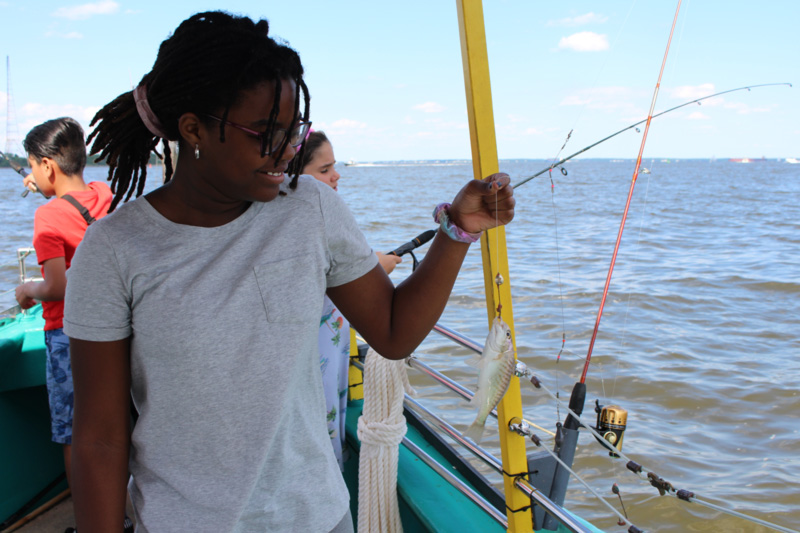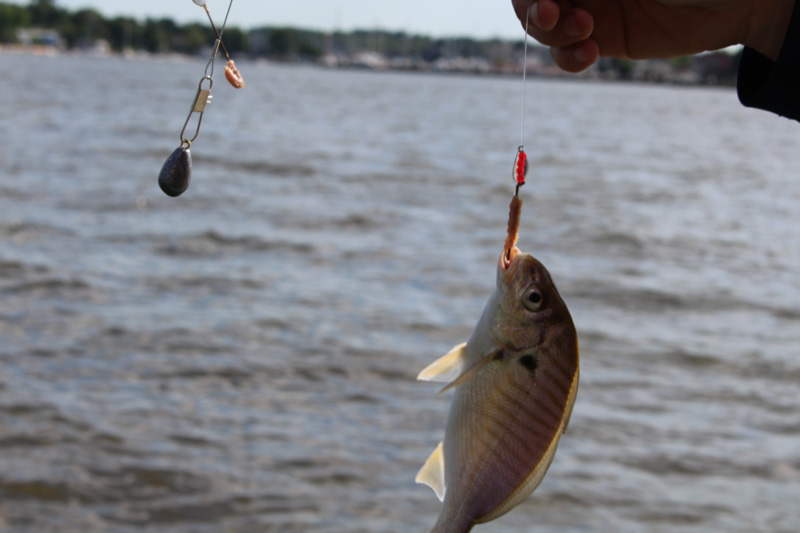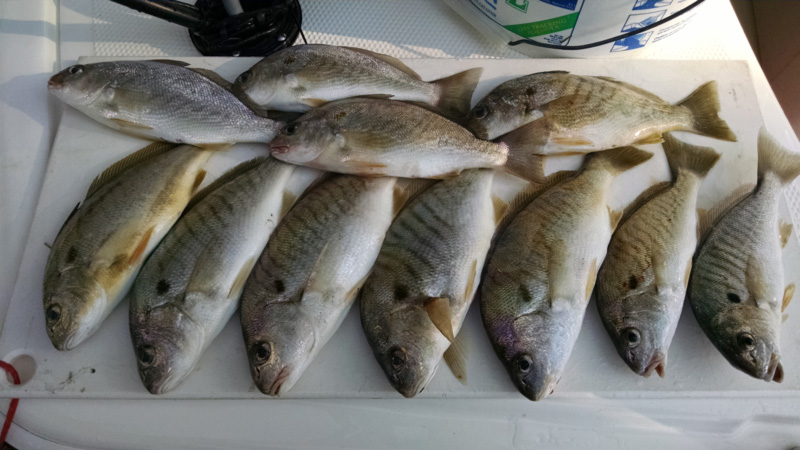I can’t remember the first fish I caught in my life, but chances are it was a spot or a croaker. I was probably about five years old. When I was young, going fishing meant spot and croaker fishing. My first trip I used a handline with a bottom rig on it. Our hooks were baited with small pieces of bloodworms or squid. I would later graduate to a very basic rod and reel combo, strung with what we called “squiding line.” This was a primitive form of braided line which reminded me of Dacron.

Spot and croaker are often mentioned together since they are caught in the same way, in the same place, using the same bait. Mature spot are broader and not as long as mature croakers. They have a distinctive spot just behind their gill plate. Croakers have a dark base to their pectoral fin, causing inexperienced anglers to confuse the two species. These days I mostly use spot and croakers for bait to catch larger fish. But in late summer or early fall I will still target larger “yellow belly” spot when they are moving out of their inshore haunts toward their fall and winter spawning grounds. “Yellow belly” refers to the tendency for the belly of spot to turn yellow late in the season.
Eating-size spot and croaker used to be abundant throughout the summer and into the fall. Though these fish are still around, the average size is much smaller these days. I’ve only found eating-size spot in late summer or early fall in recent years. We used to refer to eating-size spot as those that were two-to-the-pound. My personal best was a 1.5-pound spot caught on my friend Stan’s boat sitting at the dock, many years ago, when we were catching spot to use as bait for grey trout.
I still believe that a fried spot is one of the best eating fish out there. There’s a distinctive difference in taste between a spot and croaker; just as there is a difference in taste between red drum and black drum. In fact, I have been known to speak of black drum as giant spot and red drum as giant croakers. All four of these fish, along with grey trout, speckled trout, kingfish (also called round heads or sea mullet), and many others are part of the scientific family Sciaenidae, which makes them all cousins. Spot may be found from Massachusetts to Mexico, but the lower Chesapeake Bay is the epicenter of their existence. I am told they are often referred to as “Norfolk Spot,” but I remember old timers calling them “Ocean View Spot.”
How and Where to Catch Spot
The best way to catch spot is quite simple. The business end consists of a two-drop bottom rig (available in tackle shops, gas stations, and even some grocery stores in our region). These are constructed using wire with two droppers for attaching snelled hooks, and a snap at the bottom for a sinker. I prefer long shank number-four or number-six hooks (like those from Eagle Claw or Bear Paw) with or without spinners, and the lightest sinker I can get away with. This rig may be fished from a handline, a light spinning combo, or a conventional rod and reel.

The best place to find spot is over old oyster beds in less than 20 feet of water. The Bay along Ocean View used to be nothing but big oyster beds. Unfortunately, those days are long gone. If you are new to fishing, try a local pier or head boat. A head boat, by the way, is a fishing boat that charges by the head as opposed to a charter boat that charges by the trip. One advantage to head boat fishing is that they typically have all the tackle you will need. Another advantage is that they fish all the time and know where the fish are likely to be.
Spot are often abundant around bridges, docks, and piers. Some of my best spot fishing has been around marinas, especially marinas where tidal flow is present. Always make sure the marina allows fishing from the docks before finding out the hard way.
Spot may also be caught casting from a beach. This is especially true in the fall as they migrate south. On ocean beaches in the Mid-Atlantic region the spot are usually no more than 10 feet from where you are standing, so resist the urge to cast as far as you can.
Remember, these are bottom fish! Always make sure your rig is bouncing on the bottom. As mentioned, use the lightest sinker you can in order to keep your bait on the bottom. Spot are almost always willing to bite, which makes them an excellent target when you’re fishing with kids and need lots of fast action. Often the spot will hook themselves, and it is not unusual to catch them two at a time.
In recent years, I have replaced bloodworms with Fishbites Bag O’ Worms Bloodworm Alternative. A piece of bait less than an inch long tipped on the hook is all you need. Fishbites catch a variety of species. I’m not saying they work better than bloodworms, but they are a heck of a lot more convenient. A bag of them will last all season in my tackle bag. Fishbites come in a variety of flavors (such as squid, crab, and clam). All of these will work, but the bloodworms variety is the best for these fish.
Cleaning and Eating Spot
Begin by scaling the fish, but don’t skin it. Fried spot should be eaten with the skin on! If you are lucky enough to get into some spot around the one-pound size, you may fillet them. However, most spot are just too small to fillet. Instead, the common method is to take the head off and gut them. Once you do this, dredge them in a mixture of flour and corn meal and fry them up in hot oil. You will need to watch out for bones (backbone and ribs), but the results are worth the effort. They go well with either tartar sauce or cocktail sauce.

Corned (salted) spot used to be popular when I was young. I never tried it, but you may find recipes on the internet. I believe it was originally a cheap source of protein for folks of slender means. My dad used to say that spot and croaker kept them from starving when he was young, living in Ocean View. I have tried smoked spot dip. Simply smoke the fish skewered on rods in a smoker grill. Flake off the meat and combine it with a mixture of sour cream and cream cheese. You may add whatever seasoning you prefer. Eat the dip on crackers or chips.
We so often take the little things for granted. In the fishing world, spot are one of those little things. These fish are found anywhere there is saltwater in the Mid-Atlantic region. They are a lot of fun to catch, put up a good fight for their size, and are great to eat. They are also capable of getting a kid hooked on a lifetime of fishing. Trust me — I was that kid.
- By Chuck Harrison
Bonus Tip: Sabikis for Spot
In recent years, Hayabusa Chesapeake Sabiki rigs have become popular for catching spot. Unlike other Sabiki rigs these only have two hooks, so they’re legal for use in Maryland waters (which isn’t an issue in Virginia). With the small red flies on the hooks, all it takes is a tiny tidbit of bait or Fishbites tipping the hook for these rigs to be effective.